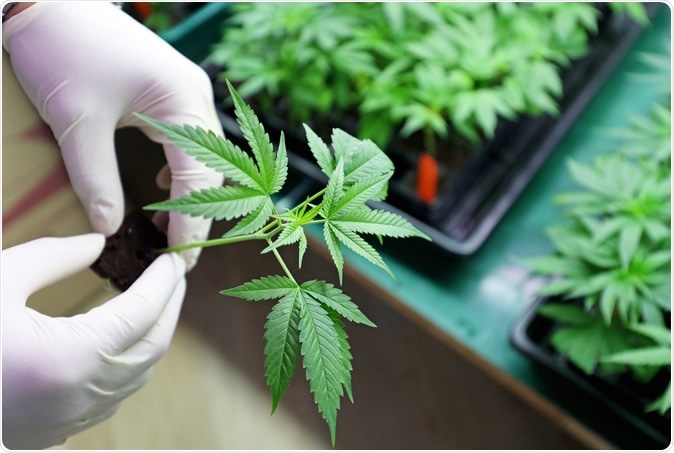A new practice guideline published in the journal CMAJ in February 2020 describes five types of drug interactions possible with the use of cannabis. Cannabis is a plant-derived drug containing the psychoactive ingredient delta-9-tetrahydrocannabinol (THC) and non-psychoactive cannabidiol (CBD). These cannabinoids are broken down by the liver enzymes cytochrome P450 C(YP)34A, and CYP2CC9.

Cannabis in lab environment. Image Credit: Photolona / Shutterstock
Drug interactions
A drug interaction is a term used to describe a reaction between two or more drugs, or between a drug and another substance found in food\s, supplements or beverages. A drug interaction can also occur if certain drugs are taken with another incompatible medical condition.
Drug interactions are important because they change the way the drug works, or may increase the possibility of side effects, or induce unexpected adverse effects. While labeling information should contain known possible drug interaction information, most customers are not aware of this.
Mechanisms of drug interaction
One way in which drug interactions occur is because of interference with the way the drug is designed to act via its target receptors. That is, other drugs or substances may antagonize or enhance the target effect of the drug, hindering its efficacy. These are called pharmacodynamic interactions.
Another way in which drug interactions interfere with drug activity is by pharmacokinetic interactions, that is, by changing the way the drug is absorbed, distributed to body tissues, metabolized, and excreted. This mode accounts for the majority of drug interactions, chiefly by a change in the expression of various enzymes that metabolize the given drug like the CYP450 family of enzymes. These enzymes can be either induced (show higher activity) or inhibited.
CYP450 induction is a time-consuming process, occurring over several days of drug exposure. The outcome is a reduction in drug plasma levels by a faster breakdown of the drug, which means the effects at a given dosage are less than expected. However, the inhibition of CYP450 is typically instantaneous, and causes a spike in plasma drug levels and therefore exaggerated drug effects, toxicities, and adverse reactions.
Cannabis compounds also bind to membrane transporters, inhibiting them.
Types of cannabis-drug interaction
Since there are various forms of cannabis, including crude and purified mixtures that have varying THC:CBD ratios, the final drug interaction will also depend on the chemical profile of the preparation. The outcome of a drug interaction can thus be additive, synergistic, or antagonistic.
Other drugs affect cannabinoid levels
However, when drugs like the antifungal ketoconazole is administered, the levels of both THC and CBDs shoot up to nearly double. This is due to the inhibitory action of ketoconazole on the enzyme CYP34A. Other CYP34A inhibitors like the macrolides and verapamil also have the potential to produce this effect, as do the CYP2C9 inhibitors like cotrimoxazole, fluoxetine, and amiodarone. This not only increases the chances of side effects but augments the psychoactive effects of THC.
Cannabinoids affect the levels of other drugs
Not only are cannabinoid levels affected by other drugs and medications, but they can influence the concentrations of other medications too. For instance, CBD inhibits CYP2C9, which leads to a tripling of the levels of the active metabolite of the drug clobazam in the body. THC is a CYP1A2 inducer, which could theoretically reduce the concentrations of psychiatric drugs like olanzapine, haloperidol, and chlorpromazine. CBD is a potent inhibitor of CYP3A4 as well, an enzyme that metabolizes about a quarter of all drugs.
Again, when marijuana is used with the anticoagulant drug warfarin, the blood clotting parameter INR is very high, resulting in markedly more significant potential for bleeding complications. CYP3A4/5 inhibition following the use of marijuana with tacrolimus has been observed to result in a three-fold increase in tacrolimus levels.
Marijuana inhalation by smoking can increase drug clearance from the body
If marijuana is smoked, the inhaled products accelerate the removal of the bronchodilator theophylline from the body by 40%. This is because of the enhanced CYP1A2 activity, which would also apply to drugs like olanzapine and clozapine in individuals who smoke more than a couple of marijuana cigarettes a week. This leads to reduced drug efficacy.
Marijuana can have additive effects or boost the effects of other drugs
For instance, if marijuana is used along with drugs that mimic or stimulate sympathetic activity, such as amphetamines, the patient may experience symptomatic or even dangerous tachycardia and hypertension. If used with drugs that inhibit the central nervous system like alcohol or other opioid drugs, the central nervous system is depressed, even more, leading to drowsiness, sleepiness, and ataxia.
When cannabis is used along with drugs that inhibit cholinergic receptors, it may worsen the tachycardia and confusion that occur with these drugs.
Implications
The knowledge of these drug interactions should serve as a warning to screen the patient or other users of marijuana for a history of other medications that may have potentially life-threatening interactions with the drug. These include the risk of dangerous bleeding, in patients on warfarin, to benzodiazepine toxicity in individuals taking clobazam. Marijuana is best avoided in combination with drugs that depress the central nervous system.
Individuals who use cannabis as a recreational or medicinal drug should be aware of the possibility of these five types of drug interactions, at least. They should probably check all other drugs and medications that they use for potential interactions with marijuana. Knowing some of the vital signs of drug interaction, as mentioned above, could help avoid drug toxicity. Physicians should advise patients on marijuana about potential interactions with any drugs, medications, or substances that they are using, and if possible, alternative drugs should be prescribed.
Journal reference:
Drug interactions with cannabinoids Tony Antoniou, Jack Bodkin, Joanne M.-W. Ho CMAJ Mar 2020, 192 (9) E206; DOI: 10.1503/cmaj.191097, https://www.cmaj.ca/content/192/9/E206